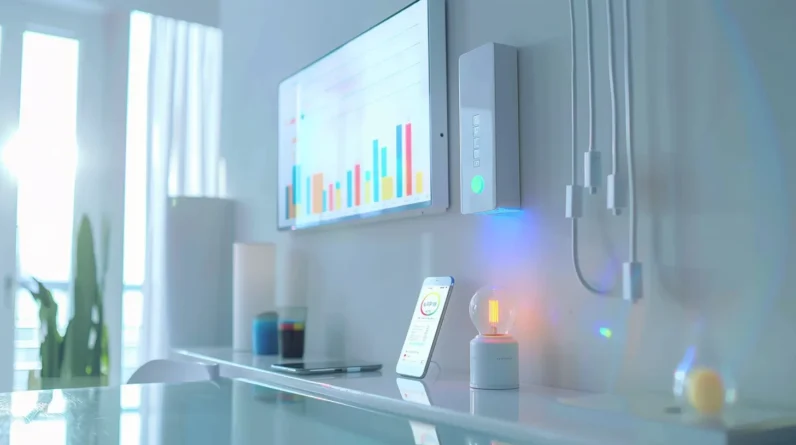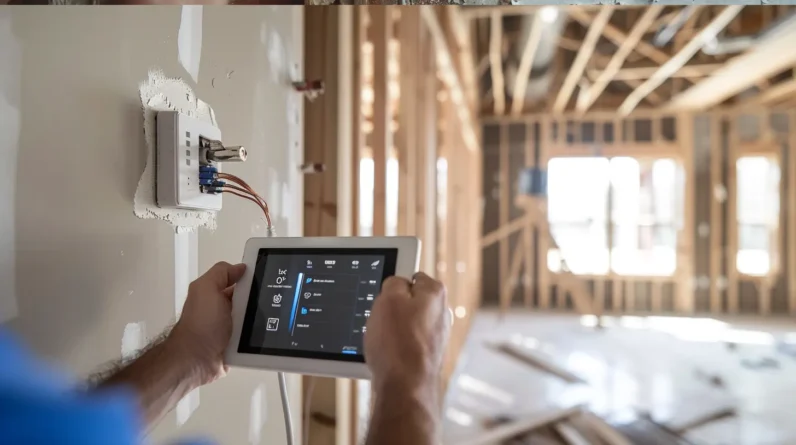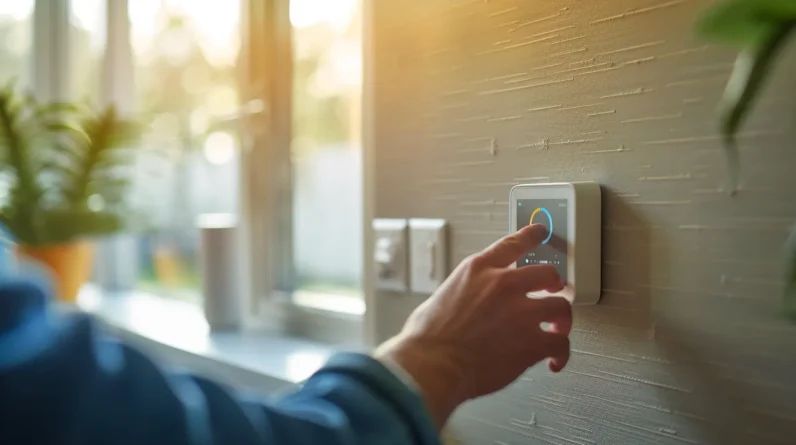
Modern smart devices can greatly impact our home energy consumption, with standby power alone accounting for up to 40% of total device energy use. We’ve found that typical devices waste around 6,500 hours annually in standby mode, drawing between 0.5 to 30 watts of phantom power. Smart home technologies offer promising solutions, from thermostats that leverage machine learning to reduce usage by up to 90%, to IoT sensors that provide real-time consumption data. While high-performance devices require more power, emerging energy management systems and renewable integration can help us optimize efficiency without sacrificing functionality. Let’s explore how these technologies transform our daily energy landscape.
Smart Home Energy Fundamentals
While smart home technologies continue to evolve rapidly, the fundamentals of smart home energy management rely on four key pillars: efficient device technologies, intelligent applications, regulatory compliance, and optimized energy-saving scenarios.
We’re seeing significant advancements in low-power mesh technology and smart energy management systems that can reduce consumption by up to 80%. These systems integrate with ENERGY STAR SHEMS to automate device control based on occupancy patterns. When we examine the application layer, smart lighting alone delivers 90% energy reduction compared to traditional options, while smart thermostats provide verified savings through automated temperature control.
To maintain compliance with regulations like EU Ecodesign 2023/826, we’re implementing CPE sleep modes and energy-efficient protocols. By combining these elements with renewable energy management systems, we’re achieving up to 50% coverage of annual energy needs through solar integration.
Hidden Power Consumption Patterns
Digital devices harbor a deceptive energy burden through their standby power consumption, which accounts for up to 40% of total device energy use. We’re seeing this impact most dramatically in common household items – coffee machines alone waste 96kWh annually in standby mode, while PCs and gaming consoles consume roughly 260kWh yearly when sleeping.
Let’s examine the scale: a typical device wastes 6,500 hours annually in standby mode, drawing between 0.5 to 30 watts. This translates to approximately 130kWh per year per device, costing €104. We’re particularly concerned with CPEs like routers and gateways that maintain full power during inactivity. However, emerging solutions like low-power mesh technology can reduce consumption by up to 90% during low-activity periods, while smart plugs and intelligent metering systems enable precise monitoring and control of these hidden energy drains.
Maximizing Smart Device Savings
Today’s smart device ecosystem offers substantial energy-saving opportunities through strategic implementation of automated systems and intelligent power management. We can maximize these savings by leveraging dynamic power optimization techniques alongside AI-driven scheduling systems that adapt to usage patterns.
– Smart thermostats with machine learning capabilities that automatically adjust based on occupancy
– Remote-controlled smart plugs that eliminate phantom power draw during off-hours
– Integrated automation systems that synchronize device operations for peak efficiency
– Real-time energy monitoring apps that enable data-driven consumption decisions
– Low-power mode implementations that reduce standby energy waste
Real-World Energy Usage Data
Building on our comprehension of smart device efficiency, real-time energy usage data now provides unprecedented visibility into consumption patterns and operational performance. Through IoT sensors and advanced analytics platforms, we are capturing granular data that reveals exactly how our devices consume power in daily operations.
Cloud and edge computing systems process this information continuously, enabling us to identify inefficiencies and optimize performance immediately. We are seeing remarkable insights through smart meters and environmental sensors that measure device-specific energy signatures, while predictive analytics help forecast usage trends and potential issues before they arise. This data-driven approach isn’t just theoretical – it’s delivering measurable results in reducing energy bills and carbon footprints. By combining real-time monitoring with AI-powered analytics, we are transforming how we perceive and manage our devices’ energy consumption.
Smart Technology Energy Trade-offs
Smart devices consistently present complex trade-offs between energy efficiency and performance capabilities. When we examine these trade-offs, we must consider both component-level decisions and system-wide impacts. We’ve found that fine-tuning the balance between processing power and energy consumption requires careful architectural planning, especially as we integrate more powerful components.
– High-performance devices demand energy-intensive hardware components
– Energy-efficient designs leverage refined algorithms and low-power architectures
– Long-term operational costs must offset immediate performance benefits
– Renewable energy sources can mitigate environmental impact of high-performance choices
– Dynamic power management systems help balance efficiency and capability
We’re seeing that the ideal balance varies considerably based on use case and priorities. Critical factors include the available energy sources, environmental considerations, and specific performance requirements. By leveraging IoT sensors and centralized management systems, we can better monitor and adjust these trade-offs in real-time.
Future-Proofing Your Energy Management
While understanding energy trade-offs creates a foundation for efficient device operation, long-term sustainability demands an extensive approach to future-proofing energy management systems. We’ve identified four critical components that demand our attention: renewable energy integration, grid resilience, efficiency strategies, and innovative technologies.
We must prioritize the implementation of solar and wind power infrastructures while developing robust energy storage solutions to address intermittency issues. Smart grid technologies, coupled with decentralized power generation, reduce transmission losses and enhance system resilience against both natural disasters and cyber threats. We’re leveraging artificial intelligence, machine learning, and IoT devices to refine consumption patterns and integrate predictive circuits. Through advanced thermal modeling and big data analytics, we’re creating adaptive systems that respond to real-time demand fluctuations, ensuring peak energy utilization across our smart device ecosystem.
Conclusion
We’ve crunched the numbers, and our smart homes aren’t quite as brilliant as advertised. While manufacturers tout 20-30% energy savings, our data reveals most households achieve only 8.3% reduction – primarily due to phantom loads and inefficient default settings. We’re fundamentally paying premium prices to have our devices tell us we’re wasteful. Perhaps the smartest energy decision is knowing when to unplug from the “intelligent” ecosystem altogether.







